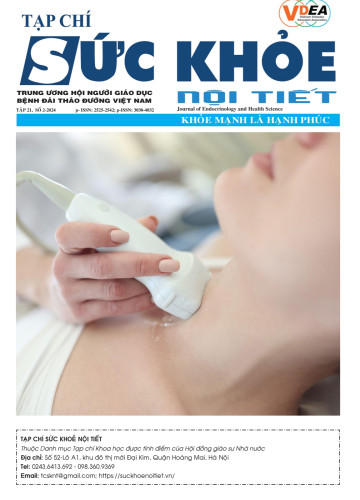Đăng ký
Vui lòng nhập các thông tin cần thiết

TÀI LIỆU THAM KHẢO
1. Tạ Văn Bình (2007), "Những nguyên lý nền tảng bệnh đái tháo đường tăng glucose máu", Nhà xuất bản Y học, pp. 19.
2. Trần Thị Đoàn (2011), "Nghiên cứu rối loạn lipid máu ở bệnh nhân tiền Đái tháo đường", Luận văn thạc sỹ Y học, pp.
3. Nguyễn Hải Thủy (2009), "Ý nghĩa các thành tố trong hội chứng chuyển hóa", Kỷ yếu toàn văn các đề tài nghiên cứu khoa học đại hội và hội nghị nội khoa toàn quốc lần thứ VI, pp. 71 - 90.
4. Earl S. Ford;Chaoyang Li (2008), "Metabolic Syndrome and Incident Diabetes: Current state of the evidence", Diabetes Care 30, pp. 1898 - 1904.
5. Genuth S; Alberti KG; Bennett P et al (2003), "Follow-up report on the diagnosis of diabetes mellitus", Diabetes Care, 26, pp. 3160.
6. International Diabetes Federation (2006), "The IDF consensus worldwide definition of the metabolic syndrome", pp. 1-7.
7. Lawlor D.A.; Ebrahim S (2004), "The metabolic syndrome and coronary heart disease in older women: findings from the British women's heart and heal the study", Diabetic Medicine, 21, pp. 906-950.
8. Reaven Gm (1988), "Role of insulin resistance in human disease", Diabetes 37, pp. 1595-1607.
9. Vông Khăm Phoong Phu Vông (2009), "Nghiên cứu sinh lý chức năng tế bào beta, độ nhậy insulin qua mô hình homa2 ở người tiền đái tháo đường", Luận văn thạc sỹ Y học, Học viện Quân Y, pp.
Mục tiêu: Nghiên cứu nhằm đánh giá vai trò, ý nghĩa các tiêu chí, để sử dụng hiệu quả các tiêu chuẩn chẩn đoán hội chứng chuyển hóa.
Phương pháp: 948 đối tượng tiền đái tháo đường (30–69) được lựa chọn, khám lâm sàng, xét nghiệm nghiệm pháp tăng đường máu, lipid máu để phân tích tần suất xuất hiện các tiêu chí của hội chứng chuyển hóa.
Kết quả: Tần suất xuất hiện các tiêu chí của HCCH theo IDF lần lượt là: tăng VE (100%), THA (84,7%), tăng ĐH (81,7%), giảm HDL-C (66,4%), tăng TG (60,5%). Tần suất các kiểu phối hợp các tiêu chí của HCCH theo IDF (3 tiêu chí, 4 tiêu chí, 5 tiêu chí) là 32,9%, 40,9%, 26,2%. Tần suất xuất hiện các tiêu chí của HCCH theo ATPIII lần lượt là THA (89,8%), tăng ĐH (87,8%), tăng TG (79%), giảm HDL-C (70,2%), tăng VE (15,3%). Tần suất các kiểu phối hợp các tiêu chí của HCCH theo ATPIII (3 tiêu chí, 4 tiêu chí, 5 tiêu chí) là 62%, 33,9%, 4,1%.
Kết luận: Theo IDF tần suất cao nhất của các tiêu chí HCCH là tăng VE, thấp nhất là tăng TG; 4 tiêu chí chiếm tỉ lệ nhiều nhất. Theo ATPIII, tiêu chí THA có tần suất cao nhất, tăng VE thấp nhất; các kiểu phối hợp tiêu chí giảm dần từ 3 đến 5 tiêu chí.
Từ khóa: Tiền đái tháo đường; hội chứng chuyển hóa, tiêu chí
METABOLIC SYNDROME ACCORDING TO IDF CRITERIA COMPARED WITH ATP III CRITERIA IN PREDIABETIC INDIVIDUALS IN NINH BINH
Objective: This study aimed to evaluate the role and significance of criteria for metabolic syndrome to effectively diagnose the syndrome.
Methods: 948 type 2 diabetes patients aged 30-69 years were selected for clinical examination and laboratory tests to analyze the frequency of criteria for metabolic syndrome according to IDF and ATPIII standards.
Results: The frequency of criteria according to IDF: increased waist circumference (100%), hypertension (84.7%), increased fasting glucose (81.7%), decreased HDL-C (66.4%), and increased triglycerides (60.5%); the frequency of combinations of criteria (3 criteria, 4 criteria, 5 criteria) were 32.9%, 40.9%, and 26.2%, respectively. The frequency of criteria according to ATPIII were: hypertension (89.8%), increased fasting glucose (87.8%), increased triglycerides (79%), decreased HDL-C (70.2%), and increased waist circumference (15.3%); the frequency of combinations of criteria (3 criteria, 4 criteria, 5 criteria) were 62%, 33.9%, and 4.1%, respectively.
Conclusion: According to IDF, the highest frequency of criteria was increased waist circumference, and the lowest was increased triglycerides. The most common combination of criteria was 4 criteria. According to ATPIII, hypertension had the highest frequency, while increased waist circumference had the lowest. The frequency of combinations of criteria decreased from 3 to 5 criteria.
Keywords: Type 2 diabetes, metabolic syndrome, criteria.